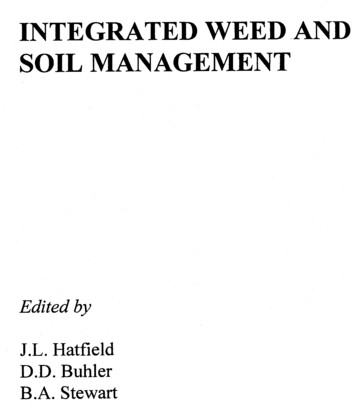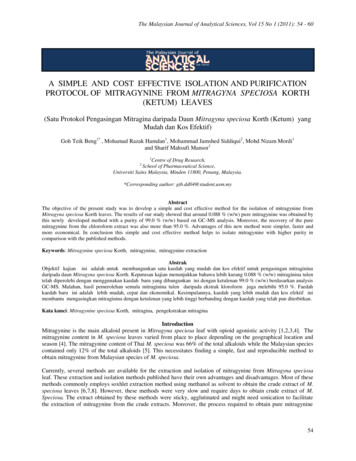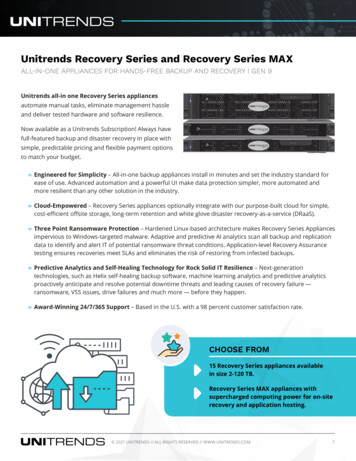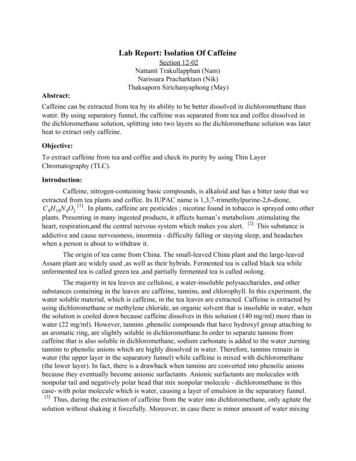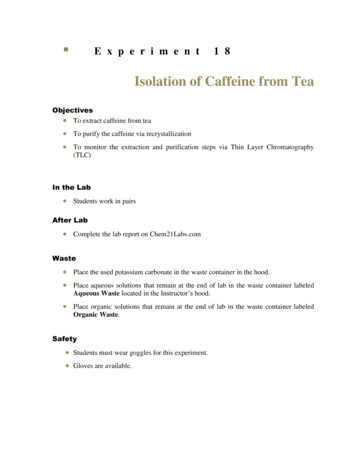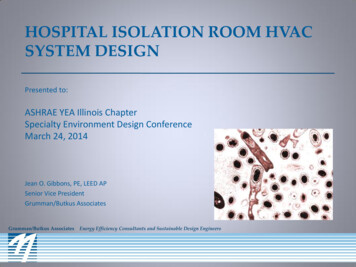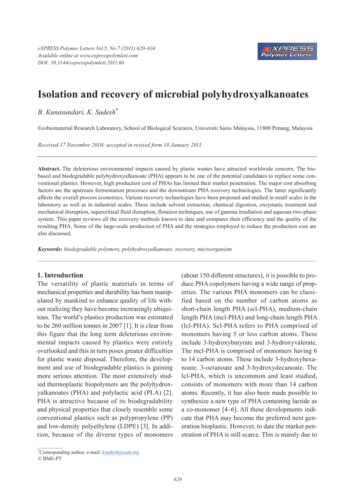
Transcription
eXPRESS Polymer Letters Vol.5, No.7 (2011) 620–634Available online at www.expresspolymlett.comDOI: 10.3144/expresspolymlett.2011.60Isolation and recovery of microbial polyhydroxyalkanoatesB. Kunasundari, K. Sudesh*Ecobiomaterial Research Laboratory, School of Biological Sciences, Universiti Sains Malaysia, 11800 Penang, MalaysiaReceived 17 November 2010; accepted in revised form 18 January 2011Abstract. The deleterious environmental impacts caused by plastic wastes have attracted worldwide concern. The biobased and biodegradable polyhydroxyalkanoate (PHA) appears to be one of the potential candidates to replace some conventional plastics. However, high production cost of PHAs has limited their market penetration. The major cost absorbingfactors are the upstream fermentation processes and the downstream PHA recovery technologies. The latter significantlyaffects the overall process economics. Various recovery technologies have been proposed and studied in small scales in thelaboratory as well as in industrial scales. These include solvent extraction, chemical digestion, enzymatic treatment andmechanical disruption, supercritical fluid disruption, flotation techniques, use of gamma irradiation and aqueous two-phasesystem. This paper reviews all the recovery methods known to date and compares their efficiency and the quality of theresulting PHA. Some of the large-scale production of PHA and the strategies employed to reduce the production cost arealso discussed.Keywords: biodegradable polymers, polyhydroxyalkanoate, recovery, microorganism1. IntroductionThe versatility of plastic materials in terms ofmechanical properties and durability has been manipulated by mankind to enhance quality of life without realizing they have become increasingly ubiquitous. The world’s plastics production was estimatedto be 260 million tonnes in 2007 [1]. It is clear fromthis figure that the long term deleterious environmental impacts caused by plastics were entirelyoverlooked and this in turn poses greater difficultiesfor plastic waste disposal. Therefore, the development and use of biodegradable plastics is gainingmore serious attention. The most extensively studied thermoplastic biopolymers are the polyhydroxyalkanoates (PHA) and polylactic acid (PLA) [2].PHA is attractive because of its biodegradabilityand physical properties that closely resemble someconventional plastics such as polypropylene (PP)and low-density polyethylene (LDPE) [3]. In addition, because of the diverse types of monomers*Corresponding BME-PT(about 150 different structures), it is possible to produce PHA copolymers having a wide range of properties. The various PHA monomers can be classified based on the number of carbon atoms asshort-chain length PHA (scl-PHA), medium-chainlength PHA (mcl-PHA) and long-chain length PHA(lcl-PHA). Scl-PHA refers to PHA comprised ofmonomers having 5 or less carbon atoms. Theseinclude 3-hydroxybutyrate and 3-hydroxyvalerate.The mcl-PHA is comprised of monomers having 6to 14 carbon atoms. These include 3-hydroxyhexanoate, 3-octanoate and 3-hydroxydecanoate. Thelcl-PHA, which is uncommon and least studied,consists of monomers with more than 14 carbonatoms. Recently, it has also been made possible tosynthesize a new type of PHA containing lactide asa co-monomer [4–6]. All these developments indicate that PHA may become the preferred next generation bioplastic. However, to date the market penetration of PHA is still scarce. This is mainly due toauthor, e-mail: ksudesh@usm.my620
Kunasundari and Sudesh – eXPRESS Polymer Letters Vol.5, No.7 (2011) 620–634its high production cost. The main reasons behindthe economic disadvantages are the costly fermentation and purification technologies. The latter significantly affects the overall process economics.Much work has been carried out to lower the PHAproduction cost by the use of effective and inexpensive carbon source and genetically engineeredmicroorganisms. Sugars have been shown to be aneffective feedstock for PHA production in Brazil,especially when the PHA production is integrated tothe sugarcane-processing factory [7]. On the otherhand, it has been demonstrated that vegetable oilsare also potential feedstock for PHA production [8–12] in countries like Malaysia where palm oil isproduced in very large scales. High levels of PHAaccumulation have been achieved using crude palmkernel oil. The yield of PHA from vegetable oils isat least two times the yield of PHA from sugars[13]. However, the real cost associated with PHAwould only diminish with the development of acheaper and environmentally friendly PHA recovery method. This article reviews the currently knownmethods for the recovery of PHA. Some of thelarge-scale production of PHA and the strategiesemployed to reduce the production cost are also discussed.2. PHA biosynthesisPHA is a lipid-like compound synthesized by manymicroorganisms as a form of storage material. UponFigure 1. Morphology of PHA granules in the bacterial cells observed under (a) Phase contrast and (b) Transmission Electron Microscope. (c) Atomic force microscope deflection image showing the presence of globular particles on thegranule surface. (d) A model representing the native PHA granule with a protein monolayer on the surface (Notdrawn according to actual scale)621
Kunasundari and Sudesh – eXPRESS Polymer Letters Vol.5, No.7 (2011) 620–634synthesis, PHA is accumulated in the form of granules in the bacterial cell cytoplasm. The averagesize of the PHA granules is approximately 0.2–0.5 !m (Figure 1). Figure 1 shows the morphologyof PHA granules when observed using variousmicroscopy techniques. Atomic force microscopyanalysis has shown the presence of a protein monolayer on the surface of PHA granules [14–15]. Inorder to recover the PHA granules, it is necessary torupture the bacterial cell and remove the proteinlayer that coats the PHA granules. Alternatively, thePHA has to be selectively dissolved in a suitablesolvent. Formation of PHA granules is dependenton the presence of suitable metabolic pathways. Figure 2 shows a simplified metabolic pathway for thebiosynthesis of poly(3-hydroxybutyrate) [P(3HB)],which is the most common type of PHA. The biosynthesis of P(3HB) is initiated by the condensationof two acetyl-CoA molecules by "-ketothiolase(PhaA) to form acetoacetyl-CoA. Subsequently,NADPH-dependent acetoacetyl-CoA reductase(PhaB) catalyzes the reduction of acetoacetyl-CoAto the (R)-isomer of 3-hydroxybutyryl-CoA whichis then polymerized into P(3HB) by the PHA synthase (PhaC) [3]. To date, Cupriavidus necator (formerly known as Wautersia eutropha, Ralstoniaeutropha and Alcaligenes eutrophus) is the mostextensively studied microorganism for the cost-effective production of PHA. Numerous other strains suchas Bacillus cereus SPV, Sinorhizobium meliloti,Azotobacter chroococcum G-3, Pseudomonas putidaKT2440 and Metylobacterium sp V49 also gainingattention for the PHA production. Besides wild-typestrains, recombinant strains are also being devel-Figure 2. The most studied metabolic pathway for thebiosynthesis of polyhydroxyalkanoates (PHA)oped. Various types of recombinant Escherichia colistrains are able to synthesize PHA to high intracellular level and some are amenable to geneticallymediated lysis system to facilitate the release of thePHA granules [16]. Compared to the extensiveresearch on the biosynthesis of PHA, research onthe downstream processing of PHA is scarce. Table 1shows the various extraction methods that havebeen reported. The following section will describeall these methods and finally compare their advantages and disadvantages (Table 2). This study isimportant to choose a suitable method that couldeffectively isolate PHA from the microbial cells.3. Recovery techniques for the isolation andpurification of PHA from microbial cells3.1. Solvent extractionSolvent extraction is the most extensively adoptedmethod to recover PHA from the cell biomass(Table 1). This method is also used routinely in thelaboratory because of its simplicity and rapidity.Two main steps are involved, first is the modification of cell membrane permeability thus allowingrelease and solubilization of PHA. This is then followed by non-solvent precipitation [17]. Extractionof PHA with solvents such as chlorinated hydrocarbons, i.e. chloroform, 1,2-dichloroethane [18] orsome cyclic carbonates like ethylene carbonate and1,2-propylene carbonate [19] is common. Lowerchain ketone such as acetone is the most prominentsolvent especially for the extraction of mcl-PHA[20]. Precipitation of PHA is commonly induced bynon-solvent such as methanol and ethanol [18]. Solvent extraction has undoubted advantages over theother extraction methods of PHA in terms of efficiency. This method is also able to remove bacterialendotoxin and causes negligible degradation to thepolymers [17]. So, it is possible to obtain very purePHA with high molecular weights. Unfortunately,large-scale application of solvent extraction is generally viewed as a method that is not environmentally friendly. In addition, several other factors discourage the use of solvents such as high capital andoperational costs. Another problem is the high viscosity of the extracted polymer solution when theP(3HB) concentration exceeds 5% (w/v) (Table 2).The viscosity of the solution interferes with celldebris removal resulting in lengthy separationprocess. Besides, there is a possibility that solvent622
Kunasundari and Sudesh – eXPRESS Polymer Letters Vol.5, No.7 (2011) 620–634Table 1. Various PHA recovery methods that have been reportedExtraction methodSolvent e carbonateAcetone-water processMethyl tert-butyl etherMethylene chlorideNon halogenated solventsisoamy propionate, propylbutyrate, isoamyl valerat etc.Acetone, room temperatureDigestion methodSurfactantSDSPalmitoyl carnitineSodium t-ChelateSodium hypochloriteSodium hypochloriteSDS-Sodium hypochloriteTriton X-100-sodiumhypochloriteTriton X-100-EDTABetaine-EDTA disodium saltStrainBacillus cereus SPVCupriavidus necatorDSM 545C. necator DSM 545Pseudomonas putidaKT2440C. necatorC. necatorResultsReferencePurity: 92%; Yield: 31% Valappil et al. [31]Purity: 95%; Yield: 96% Fiorese et al. [25]Purity: 84%; Yield:95% Fiorese et al. [25]Yield: 80–85%Narasimhan et al. [65]Yield: 15–17.5 wt%Wampfler et al. [26]Purity: 98%Zinn et al. [66]Mantelatto and Durao[67]P. putida GPo1Yield: 94%Elbahloul and Steinbüchel [64]RecombinantEscherichia coliC. necator,Alcaligenes latusC. necator,Recombinant E. coliC. necator DSM 545Azotobacter chroococcum G-3C. necator DSM 545Purity: 99%; Yield:89% Choi and Lee [54]Degree of lysis: 56–78%Purity: 86%;Purity: 93%Purity: 98%Purity: 98%; Yield: 87%Lee et al. [68]Purity: 98%Ramsay et al. [27]Sinorhizobium melilotiPurity: 68%C. necator DSM 545Lakshman and Shamala[34]Chen et al. [33]Purity: #96%; Yield:90%Purity: 95%; Yield: 30% Valappil et al. [31]Hahn et al. [69]Berger et al. [70]Dong and Sun [28]Dispersion of sodiumChloroform- sodiumhypochlorite and chloro- hypochloriteformChloroform- sodiumhypochloriteSelective dissolution by Sulfuric acidprotonsEnzymatic digestionMicrobispora sp culture-chloroformEnzyme combined with SDSEDTABromelain; pancreatinB. cereus SPVMechanical disruptionBead millHigh pressure homogenizationSDS-High pressure homogenizationSonicationSC-CO2ChloroformA. latusTamer et al. [23]A. latusTamer et al. [23]Metylobacterium sp V49 Purity: 95%; Yield: 98% Ghatnekar et al. [48]Sodium hypochloriteB. flexusAlkaline hydrolysisB. flexusChloroformZobellella denitrificansMW1P. putidaSupercritical fluidCell fragilitySelf flotation of celldebrisDissolved air flotationC. necator,Recombinant E. coliC. necatorPurity: #98%Hahn et al. [69]Yu and Chen [21]S. melilotiPurity: #97%; Yield: 95%Purity: 94%P. putidaPurity: 93%C. necatorPurity: 89%; Purity:90%Bacillus flexusC. necatorB. flexusEnzymatic hydrolysis, sonification, flotationAqueous two phase sys- Microbispora sp culture-ATPS B. flexustemGamma irradiationRadiation-chloroformB. flexusAir classificationSpontaneous liberationE. coliC. necatorE. coli623Lakshman and Shamala[34]Kathiraser et al. [71]Kapritchkoff et al. [39]Purity: 92%; Yield: 20% Divyashree et al. [37]Yield: 89%Hejazi et al. [49]Yield: 43%Divyashree andShamala [56]Yield: 50%Divyashree andShamala [56]Yield: 50%Divyashree andShamala [56]Purity: 98%; Yield: 85% Ibrahim and Steinbüchel[57]Purity: 86%van Hee et al. [58]Purity: 95%; Yield: 50% Divyashree et al. [37]Yield: 45–54%Divyashree andShamala [61]Purity: 97%; Yield: 90% Noda [72]Purity: 95%; Yield: 85% Noda [72]Autolysis of 80%Jung et al. [73]
Kunasundari and Sudesh – eXPRESS Polymer Letters Vol.5, No.7 (2011) 620–634Table 2. Comparison of the advantages and disadvantages of various PHA extraction methodsRecovery methodSolvent extractionAdvantagesRemoval of endotoxinUseful for medical applicationsHigh purityNegligible/limited degradation to the polymerHigher molecular weightChemical DigestionSurfactantExtracted PHA retains original molecular weightNative order of polymer chains in PHA granules isretainedHigher purity of PHA can be obtainedSodium hypochloriteSequential surfactanthypochloriteHigh quality of PHARapid recovery and simple processRetain native order of polymer chains in PHA granulesLower operating cost compared to solvent extractionDispersion sodiumHigh purity of PHAhypochlorite and solReduced viscosity of solvent phase due to digestion ofvent extractionnon-polymer cellular material (NPCM) by sodiumhypochloriteSurfactant-chelateConvenient operationHigh quality of productSelective dissolution of Low operating costNPCM by protonsHigher recovery yieldEnzymatic digestionMild operation conditionsGood recovery with good qualityBead millNo chemicals usedLess contaminationNot susceptible to blockagesNo micronization of PHA granulesHigh pressure homoge- No chemicals usednizationLess contaminationSupercriti
(about 150 different structures), it is possible to pro-duce PHA copolymers having a wide range of prop-erties. The various PHA monomers can be classi-fied based on the number of carbon atoms as short-chain length PHA (scl-PHA), medium-chain length PHA (mcl-PHA) and long-chain length PHA (lcl-PHA). Scl-PHA refers to PHA comprised of monomers having 5 or less carbon atoms. These include 3 .
